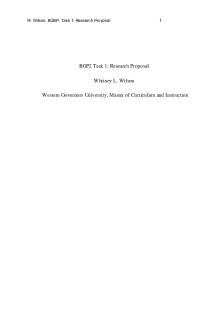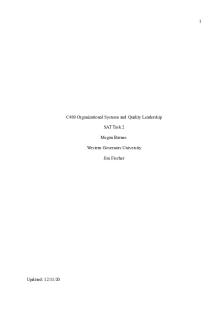C489 Task 1 - passed with no revisions PDF

| Title | C489 Task 1 - passed with no revisions |
|---|---|
| Course | Organizational Behavior and Leadership |
| Institution | Western Governors University |
| Pages | 4 |
| File Size | 78.3 KB |
| File Type | |
| Total Downloads | 32 |
| Total Views | 148 |
Summary
C489 Task 1 - passed with no revisions...
Description
1
Task 1
Name Western Governors University Organizational Systems and Quality Leadership Instructor April 29, 2021
2 Task 1 Nursing Quality Indicators The NDNQI (National Database of Nursing Quality Indicators) was created by the American Nurses Association in 1998 to collect data related to factors that influence the quality of nursing care (Montalvo, 2007). There are fourteen indicators including falls, restraints and pressure ulcers. It is likely Mr. J’s dementia led to impulsivity with getting out of bed unassisted, causing him to classify as a high fall risk patient and leading the nursing staff to apply restraints for his safety. Applying nursing quality indicators could have allowed the nurse of Mr. J to assess for skin breakdown related to being restrained and assist him with repositioning every 2 hours to alleviate pressure. Had these indicators been identified, Mr. J could have had better quality care and a better patient outcome. Advance Quality Patient Care The hospital could advance quality patient care by analyzing data pertaining to the number of falls and incidences of pressure ulcers related to the use of restraints. Education could be offered on appropriate assessment and care of patients who are restrained. Alternate measures could be used in place of restraints for high fall risk patients such as bed alarms, bedside sitters, or camera monitoring systems that allow for a visual of the patient when they are alone in their room. After implementing these changes to the nursing quality indicators, the hospital could analyze the new data to determine if the number of falls and incidences of pressure ulcers has decreased. Analyze specific system resources, referrals, or colleagues to resolve an ethical issue Mr. J had a diet order of “regular, kosher, chopped meat,” verifying that his diet was in the system correctly but was prepared and delivered by staff incorrectly. There were clear
3 failures of communication as evidenced by a supervisor telling the nurse to “just keep it quiet” and the nurse telling the daughter “half a pork cutlet never killed anyone.” As the nursing supervisor managing this ethical issue, I would hold a staff meeting that would include education on patient preferences relating to religion or culture. I would have a discussion with the kitchen supervisor and include a hospital dietician to ensure patient’s dietary wishes are respected. I would also suggest having the dietary aides check the trays after they’ve been completed but prior to delivery to ensure the food selection is appropriate for the patient and matches the diet order. A physician voiced concern over the number of complaints pertaining to the diet orders of Jewish patients, and these changes in preparation, communication and delivery could prevent ethical misunderstandings in the future.
4 References
Montalvo, I. (2007, September 30). The National Database of Nursing Quality Indicators® (NDNQI®). Retrieved April 28, 2021 from https://ojin.nursingworld.org/MainMenuCategories/ANAMarketplace/ANAPeriodicals/OJI N/TableofContents/Volume122007/No3Sept07/NursingQualityIndicators.aspx....
Similar Free PDFs

C493 Task 1 Passed with no revisions
- 12 Pages

C361 - passed with no revisions
- 4 Pages

C229 Task 1 No Revisions Needed
- 12 Pages

TAT2 Task 1: Passed
- 14 Pages

C227 Task 1 - Passed Task
- 22 Pages

D082 Task 1- PASSED
- 2 Pages

Task 1 C489 - Grade: B
- 5 Pages

C489 Task Two - Task 2
- 7 Pages

C206 Task 1 V2 - Task 1 Passed.
- 11 Pages
Popular Institutions
- Tinajero National High School - Annex
- Politeknik Caltex Riau
- Yokohama City University
- SGT University
- University of Al-Qadisiyah
- Divine Word College of Vigan
- Techniek College Rotterdam
- Universidade de Santiago
- Universiti Teknologi MARA Cawangan Johor Kampus Pasir Gudang
- Poltekkes Kemenkes Yogyakarta
- Baguio City National High School
- Colegio san marcos
- preparatoria uno
- Centro de Bachillerato Tecnológico Industrial y de Servicios No. 107
- Dalian Maritime University
- Quang Trung Secondary School
- Colegio Tecnológico en Informática
- Corporación Regional de Educación Superior
- Grupo CEDVA
- Dar Al Uloom University
- Centro de Estudios Preuniversitarios de la Universidad Nacional de Ingeniería
- 上智大学
- Aakash International School, Nuna Majara
- San Felipe Neri Catholic School
- Kang Chiao International School - New Taipei City
- Misamis Occidental National High School
- Institución Educativa Escuela Normal Juan Ladrilleros
- Kolehiyo ng Pantukan
- Batanes State College
- Instituto Continental
- Sekolah Menengah Kejuruan Kesehatan Kaltara (Tarakan)
- Colegio de La Inmaculada Concepcion - Cebu






